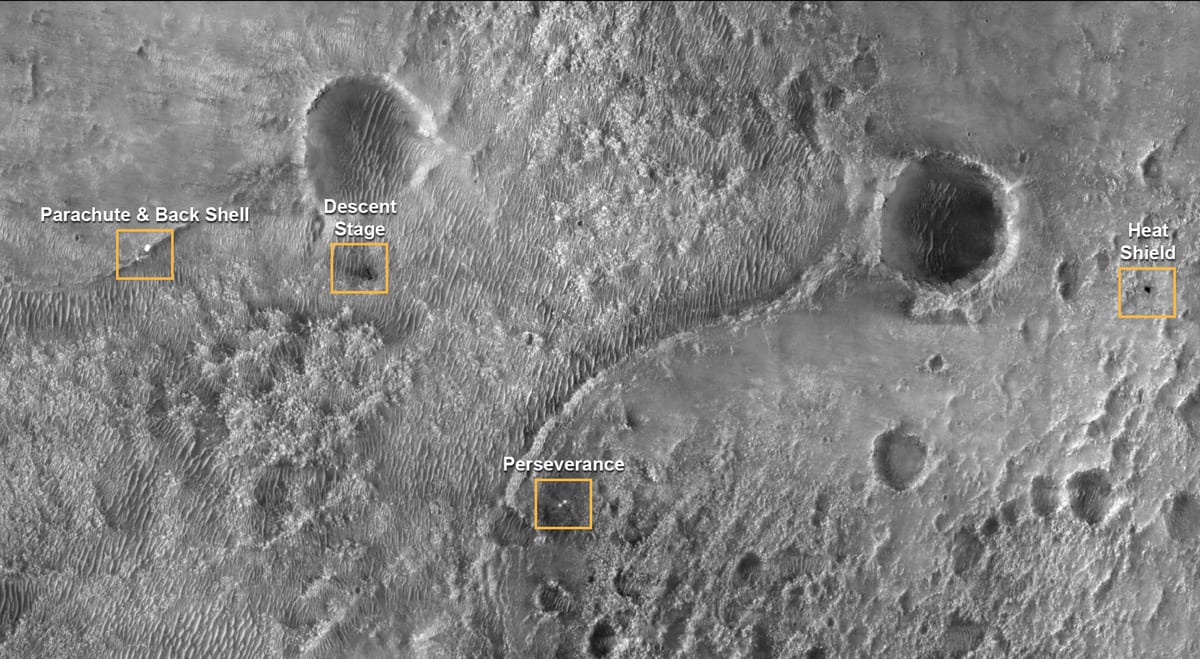
This first image of NASA’s Perseverance Rover on the surface of Mars from the HiRISE camera aboard NASA’s Mars Reconnaissance Orbiter shows many parts of the Mars 2020 mission landing system that got the rover safely on the ground. (NASA/JPL-Caltech/University of Arizona)
As NASA’s Perseverance Mars rover relays high definition imagery and video to mission control at NASA’s Jet Propulsion Laboratory in Southern California the ground vehicle’s robotic arm is preparing to drill into, take pictures of and analyze minerals, chemicals, and other critical sources of life on the Red Planet.
Perseverance, landed on Mars on Thursday, Feb. 18, at 3:55 EST after a 203-day journey traveling over 293 million miles. NASA/JPL’s Mars Exploration program is to collect samples from Mars and bring them back to Earth.
Rover landed on Mars after launching on July 30, 2020, during one of the revolving two-year launch windows that exist during periods where the Earth’s orbit aligns with Mars making such journeys more optimal and easier to accomplish. Mars 2020, the NASA/JPL mission, has tasked the Rover with searching for signs of past microbial life that might have existed on Mars.
Among the most visible technologies featured on the 2,263-pound car-sized Rover is its 7-foot long primary robotic arm. During the mission, the arm will allow the rover to drill through Martian rocks to collect core samples, operate scientific instruments that will take images and perform analysis of the Martian surface, and deposit samples in the rover’s chassis, according to NASA.
NASA has partnered with other domestic and international space agencies to ensure that samples collected from the Perseverance mission are returned to Earth for laboratory analysis around 2030. The length of the robotic arm at just seven feet will need to be extremely precise when performing its mission, as its turret holds a 45-pound payload that includes key instrumentation to enable the discovery of signs of life.

The first image of Mars surface captured by the rover.
“I compare it to a person trying to hold a bag of concrete straight out and then position that bag while holding it performs work precisely. It is not an insignificant task,” Tom McCarthy, VP of business development for Motiv Space Systems, told Aviation Today. Motiv is the company that supplied the robotic arm to NASA/JPL for the Mars 2020 mission.
McCarthy said Motiv also included a force-torque sensor that enables six degrees of freedom of range of movement for the arm. Instruments featured on the robotic arm can study an area of Mars that is about the size of a postage stamp in great detail.
“On the arm, there is Scanning Habitable Environments with Raman & Luminescence for Organics & Chemicals (SHERLOC), which is an ultraviolet spectrometer and that studies mineralogy and chemistry. Another camera featured on the arm is called Wide Angle Topographic Sensor for Operations and Engineering (WATSON), and it works together with SHERLOC for doing inspections of rock and soil,” McCarthy said.
Planetary Instrument for X-ray Lithochemistry (PIXL) is another instrument featured on the arm, an X-ray spectrometer that will perform chemical composition investigation. WATSON’s imager will also be mapping out the presence of carbo-based minerals and organic materials that are similar to those that serve as building blocks for life on earth, according to NASA.
Motiv also supplied the Rover’s Mastcam-Z cameras, featuring focus and zoom mechanisms designed to bring depth and color to the images collected by the rover during its mission, allowing vivid HD video to be sent back to Earth. A filter wheel developed by Motiv for the same
Mastcam-Z instrument allows the NASA/JPL team to select from eight optical elements, each designed to filter a specific wavelength of light to allow for important scientific observations.
“As valuable as the scientific insights we gain this in the coming weeks from the rover are likely to be, I expect to pale in comparison to what we can learn about Mars once we get the samples back on earth,” Chris Thayer, President and CEO of Motiv Space Systems, said in a Feb. 18 press release published by Motiv.
NASA has already started publishing insights about what it has learned about the Red Planet since the rover’s landing, including a breakdown of its entry into Mars atmosphere and its landing at the Jezero Crater.
“For those who wonder how you land on Mars – or why it is so difficult – or how cool it would be to do so – you need to look no further,” Acting NASA Administrator Steve Jurczyk said in a Feb. 22 NASA press release. “Perseverance is just getting started, and already has provided some of the most iconic visuals in space exploration history. It reinforces the remarkable level of engineering and precision that is required to build and fly a vehicle to the Red Planet.”